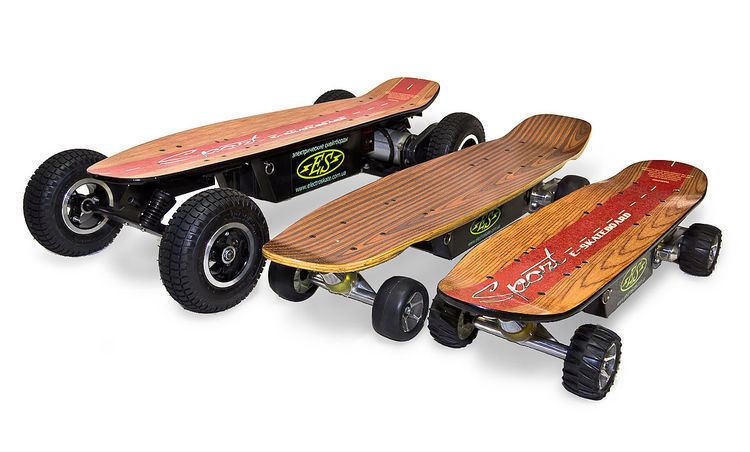 | ||
An electric skateboard is typically a modified skateboard propelled by an electric motor, the power of which is usually controlled with an RF remote. As with a regular skateboard, it is steered by the rider shifting his or her weight. It was originally designed for local transport, but now offer a more serious "Off Road" model as a new thrill sport. The Off Road style boards are able to traverse grass, gravel, dirt and hard sand with ease and are often seen at low tide on the beach.
Contents
Battery and range
The typical range for an 800-watt unit with a LiFePO4 battery is between 16 and 20 km (9–12 miles). 600 W units achieve 20% less range than their 800 W counterparts, and units using the older sealed lead acid batteries achieve 30% less range than those using the LiFePO4 batteries. The maximum speed of a typical electric skateboard is about 25–40 kilometres per hour (16–25 mph).
Many manufacturers now offer 12 Ah LiFePO4 packs as an optional upgrade over the more standard SLA battery packs, which reduces the weight of the boards by 10 kg (LiFePO4 packs weigh in at 5 kg compared to the 15 kg of the standard SLA pack). This results in a lighter, more agile board. Additionally, discharge chemistry of a LiFePO4 battery allows the motor to run at top speed constantly until the battery is exhausted, compared to the initial high current from an SLA battery which quickly tapers off as it discharges. Furthermore, a high quality 12 Ah-rated LiFePO4 pack can realistically deliver 9–10 Ah, compared to a 12 Ah-rated SLA pack which realistically delivers 7–8 Ah due to the high energy demands of an electric skateboard's motor (typically 25–35 amps when riding at high speed, over rough or sloping terrain).
By increasing the battery capacity to 20 Ah (using small-factor LiFePO4 pouch cells), ranges of 30 kilometers or more can be achieved even when riding at constant high speed. In 2016, four companies started to offer electric skateboards with the ability to run over 30km with an 8Ah battery unlike their predecessors who offer up to 25km and cost almost double.
History
The first mass-produced powered skateboard was the Motoboard. It was first created in the summer of 1975. The Motoboard is gasoline powered and served as a grandfather to the electric skateboards we have today.
The Motoboard, and similar skateboards, were banned in the mid-1970s in California under section 21968., as their gas engines cause a lot of pollution and were extremely loud. Most of developments for motorized skateboards, however, have occurred in California. Modesto Assemblywomen Kirsten Olsen is leading the change to make electric skateboards legal in California by proposing bill no. 2054 which would legalize motorized skateboards if they ran off of electricity, not gas; their motor would be under 1,000 watts; they could not go faster than 20 mph; and have electric skateboard manufacturers to disclose to their consumers that their insurance policy may not cover electric skateboards. The bill was submitted February 20, 2014, and has yet to be voted upon.
Electric skateboards came into the public eye more recently when a number of different companies started raising funds through crowdfunding website Kickstarter.
Laws
The United States has many states that have a variety of laws that differ from one another. In some cities like New York, self-balancing scooters are currently banned from being used on public roads but there is no current explanation from the law makers for electric skateboards.
Currently, the United Kingdom has no laws around the use of electric skateboards but due to the ever increasing claims from insurance companies, there has been a petition in relation to electric powered vehicles from the Mayor of London, Boris Johnson. In March 2016 a meeting is being held in London to talk about the use of electric powered vehicles and what benefits they have to the environment. This is a push for the use of electric powered vehicles - however there are large numbers of people who do not want to see electric powered vehicles like self-balancing scooters and electric skateboards used in the streets of the UK.
In The Netherlands, any motorised skateboard is not permitted on public roads, including those driven by an electric motor.
Comparison
1 These boards are the same, but are re-branded before sale. Magneto and Melon boards are next to identical apart from a pre printed logo integrated in the grip tape.
